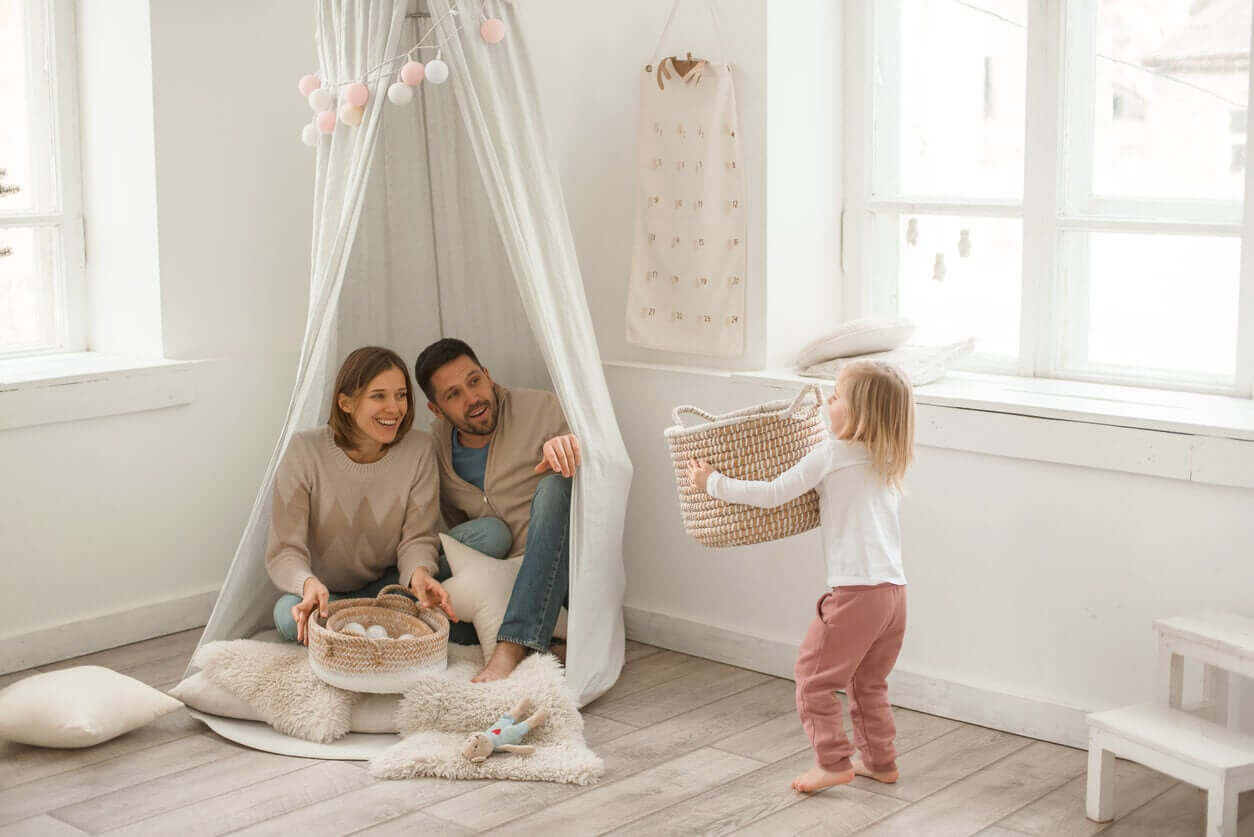How to Create the Perfect Corner to Relax at Home


Written and verified by the teacher Samanta Ruiz
Managing emotions is something that children begin to learn from the time they’re born. How to teach them to do so is the key, and that’s why today we’re going to share with you a very effective tool for this: The creation of a space to relax at home.
A calm corner or peace corner is an assigned place in the home where your child can go to manage their different emotions.
Next, we’ll explain how to put this interesting technique into practice and how to create this perfect corner for your children.
A corner to relax at home
Emotional education begins in the family environment, where children spend most of their lives. At home, they learn to live together and express what they feel and what happens to them.
But not everything is peaceful and harmonious, as everyday situations appear that exceed the ability of children to manage their emotions. Mastering skills requires active learning, and this is where practical solutions, such as a corner to relax at home, come into play.
This area is a place where children can learn to regulate and doesn’t require large architectural feats. All you need to do is prepare a corner of a room or a place under a tree. The most important thing is that your child feels comfortable enough there to go as many times as they need.

When to use the corner?
Both parents and children must learn to identify the appropriate times to use this corner, and we’ll list some of those situations below.
Before things get tense
When signs of anger appear for any reason, such as throwing toys, kicking things, or yelling, we are in the pre-event of a tantrum. As a parent, it’s good to teach your child to recognize that situation and direct them to the calm corner at that very moment.
When there’s overstimulation
In situations of overstimulation, such as after playing video games or spending several hours without resting, a critical moment comes.
Upset children go into a spiral of irritability, disrespect, or cursing, which is masked by the emotionality of the game. Faced with these episodes, the calm corner is a great place to lower their energy levels and calm down.
Whenever deemed necessary
If your child begins to go to the calm corner on their own, hug them and congratulate them! It means that they’ve managed to identify their emotions on their own and that they need to overcome what they’re feeling in order to regain balance.
A place to relax at home that children use willingly helps them to be more confident in themselves, to be independent, and much more decisive.
How to create the best corner to relax?
The space in the quiet corner can have the shape that each family chooses, although it’s very important to take into account the following aspects while creating it.
Collaborative planning
This place is for children, so listen to their suggestions. In addition, this will help make sure they’ll accept that space and agree to use it. It’s important for your children to feel involved in its creation.
Choice of functional elements
Choose with your children which elements to put there and give each one a function. In this sense, don’t presuppose anything, but find a purpose for each thing and agree on it as a family. Some useful elements to relax can be the following:
- Bubble wrap or a pop-it
- A blanket
- A cushion to sit on
- A pillow
- An anti-stress ball
- An emotions diary (for older children)
- An image to help them breathe, such as a seascape
- Art materials
- A storybook
Defining the rules for the use of space
It’s essential that you all agree about the circumstances of its use and clarify that it’s not a place of punishment or “time out”, but of reflection and relaxation.
A corner to relax at home: A smart way to deal with emotions

The calm corner is a great ally in the emotional development of your child, and you can see it yourself. Make sure to be there when their relaxation time is over and talk to your child about the need to come to that space.
Ask them to tell you how they felt before and after spending time in the corner and guide them with the correct questions to help them decode their emotions. You’ll see how your child understands much more than you think!
These types of learning and experiences help children develop their emotional intelligence.“
Emotional intelligence is the ability to perceive emotions, to access and generate emotions so as to assist thought, to understand emotions and emotional knowledge, and to reflectively regulate emotions so as to promote emotional and intellectual growth.”
– Mayer & Salovey, 1997 –
Once the child understands their emotions, they can cope more calmly in life and cope better with upsetting day-to-day situations.
Based on this strategy, they understand that this relaxation space is a useful alternative to help them overcome these uncomfortable situations on their own.
Managing emotions is something that children begin to learn from the time they’re born. How to teach them to do so is the key, and that’s why today we’re going to share with you a very effective tool for this: The creation of a space to relax at home.
A calm corner or peace corner is an assigned place in the home where your child can go to manage their different emotions.
Next, we’ll explain how to put this interesting technique into practice and how to create this perfect corner for your children.
A corner to relax at home
Emotional education begins in the family environment, where children spend most of their lives. At home, they learn to live together and express what they feel and what happens to them.
But not everything is peaceful and harmonious, as everyday situations appear that exceed the ability of children to manage their emotions. Mastering skills requires active learning, and this is where practical solutions, such as a corner to relax at home, come into play.
This area is a place where children can learn to regulate and doesn’t require large architectural feats. All you need to do is prepare a corner of a room or a place under a tree. The most important thing is that your child feels comfortable enough there to go as many times as they need.

When to use the corner?
Both parents and children must learn to identify the appropriate times to use this corner, and we’ll list some of those situations below.
Before things get tense
When signs of anger appear for any reason, such as throwing toys, kicking things, or yelling, we are in the pre-event of a tantrum. As a parent, it’s good to teach your child to recognize that situation and direct them to the calm corner at that very moment.
When there’s overstimulation
In situations of overstimulation, such as after playing video games or spending several hours without resting, a critical moment comes.
Upset children go into a spiral of irritability, disrespect, or cursing, which is masked by the emotionality of the game. Faced with these episodes, the calm corner is a great place to lower their energy levels and calm down.
Whenever deemed necessary
If your child begins to go to the calm corner on their own, hug them and congratulate them! It means that they’ve managed to identify their emotions on their own and that they need to overcome what they’re feeling in order to regain balance.
A place to relax at home that children use willingly helps them to be more confident in themselves, to be independent, and much more decisive.
How to create the best corner to relax?
The space in the quiet corner can have the shape that each family chooses, although it’s very important to take into account the following aspects while creating it.
Collaborative planning
This place is for children, so listen to their suggestions. In addition, this will help make sure they’ll accept that space and agree to use it. It’s important for your children to feel involved in its creation.
Choice of functional elements
Choose with your children which elements to put there and give each one a function. In this sense, don’t presuppose anything, but find a purpose for each thing and agree on it as a family. Some useful elements to relax can be the following:
- Bubble wrap or a pop-it
- A blanket
- A cushion to sit on
- A pillow
- An anti-stress ball
- An emotions diary (for older children)
- An image to help them breathe, such as a seascape
- Art materials
- A storybook
Defining the rules for the use of space
It’s essential that you all agree about the circumstances of its use and clarify that it’s not a place of punishment or “time out”, but of reflection and relaxation.
A corner to relax at home: A smart way to deal with emotions

The calm corner is a great ally in the emotional development of your child, and you can see it yourself. Make sure to be there when their relaxation time is over and talk to your child about the need to come to that space.
Ask them to tell you how they felt before and after spending time in the corner and guide them with the correct questions to help them decode their emotions. You’ll see how your child understands much more than you think!
These types of learning and experiences help children develop their emotional intelligence.“
Emotional intelligence is the ability to perceive emotions, to access and generate emotions so as to assist thought, to understand emotions and emotional knowledge, and to reflectively regulate emotions so as to promote emotional and intellectual growth.”
– Mayer & Salovey, 1997 –
Once the child understands their emotions, they can cope more calmly in life and cope better with upsetting day-to-day situations.
Based on this strategy, they understand that this relaxation space is a useful alternative to help them overcome these uncomfortable situations on their own.
All cited sources were thoroughly reviewed by our team to ensure their quality, reliability, currency, and validity. The bibliography of this article was considered reliable and of academic or scientific accuracy.
- Red Social Educativa de Canarias (2020). Rincones de aprendizaje: Rincón de las emociones y rincón de la calma. Gobierno de Canarias. Consejería de Educación, Universidades, Cultura y Deportes. Disponible en: https://www3.gobiernodecanarias.org/medusa/ecoblog/mcanlop/2020/07/13/rincones-de-aprendizaje-rincon-de-las-emociones-y-rincon-de-la-calma/
- Faros Sant Joan de Déu Hospital Barcelona. (2018). Claves para la educación emocional en casa. Disponible en: https://faros.hsjdbcn.org/es/articulo/claves-educacion-emocional-ambito-familiar
- Jiménez Jiménez A. Inteligencia emocional. En: AEPap (ed.). Curso de Actualización Pediatría 2018. Madrid: Lúa Ediciones 3.0; 2018. p. 457-469. Disponible en: https://www.aepap.org/sites/default/files/457-469_inteligencia_emocional.pdf
- García, E. (2012) Educar con inteligencia emocional en la familia. VI Cuaderno Faros: ¿Cómo educar las emociones? La inteligencia emocional en la infancia y la adolescencia. Disponible en: https://faros.hsjdbcn.org/sites/default/files/faros_6_cast.pdf
This text is provided for informational purposes only and does not replace consultation with a professional. If in doubt, consult your specialist.








